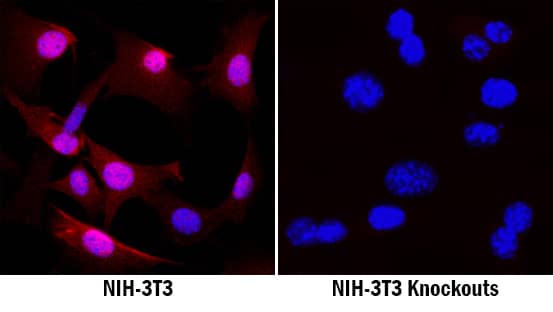Human/Mouse Annexin A1 Antibody
R&D Systems, part of Bio-Techne | Catalog # MAB3770

Key Product Details
Validated by
Species Reactivity
Applications
Label
Antibody Source
Product Specifications
Immunogen
Met1-Asn346
Accession # P04083
Specificity
Clonality
Host
Isotype
Scientific Data Images for Human/Mouse Annexin A1 Antibody
Annexin A1 in NIH-3T3 Mouse Cell Line.
Annexin A1 was detected in immersion fixed NIH-3T3 mouse embryonic fibroblast cell line (left panel, positive stain) and NIH-3T3 Knockouts (right panel, negative stain) using Mouse Anti-Human/Mouse Annexin A1 Monoclonal Antibody (Catalog # MAB3770) at 3 µg/mL for 3 hours at room temperature. Cells were stained using the NorthernLights™ 557-conjugated Anti-Mouse IgG Secondary Antibody (red; Catalog # NL007) and counterstained with DAPI (blue). Specific staining was localized to nuclei, cytoplasm and plasma membrane. View our protocol for Fluorescent ICC Staining of Cells on Coverslips.Annexin A1 in Human Breast.
Annexin A1 was detected in immersion fixed paraffin-embedded sections of human breast using Mouse Anti-Human/Mouse Annexin A1 Monoclonal Antibody (Catalog # MAB3770) at 15 µg/mL overnight at 4 °C. Before incubation with the primary antibody, tissue was subjected to heat-induced epitope retrieval using Antigen Retrieval Reagent-Basic (Catalog # CTS013). Tissue was stained using the Anti-Mouse HRP-DAB Cell & Tissue Staining Kit (brown; Catalog # CTS002) and counterstained with hematoxylin (blue). Specific staining was localized to myoepithelial cells. View our protocol for Chromogenic IHC Staining of Paraffin-embedded Tissue Sections.Applications for Human/Mouse Annexin A1 Antibody
Immunocytochemistry
Sample: Immersion fixed NIH-3T3 mouse embryonic fibroblast cell line
Immunohistochemistry
Sample: Immersion fixed paraffin-embedded sections of human breast
Knockout Validated
Reviewed Applications
Read 1 review rated 5 using MAB3770 in the following applications:
Formulation, Preparation, and Storage
Purification
Reconstitution
Formulation
Shipping
Stability & Storage
- 12 months from date of receipt, -20 to -70 °C as supplied.
- 1 month, 2 to 8 °C under sterile conditions after reconstitution.
- 6 months, -20 to -70 °C under sterile conditions after reconstitution.
Background: Annexin A1
The Annexins are a family of Calcium-dependent phospholipid-binding proteins that are preferentially located on the cytosolic face of the plasma membrane. The Annexin’s have a molecular weight of approximately 35 to 40 kDa and consist of a unique amino terminal domain followed by a homologous C-terminal core domain containing the calcium-dependent phospholipid-binding sites. The C‑terminal domain is comprised of four 60‑70 amino acid repeats, known as annexin repeats or an endonexin fold (Annexin A6 contains 8 annexin repeats). The four annexin repeats form a highly alpha-helical, tightly packed disc known as the annexin domain, which binds to phospholipids in the membrane in a calcium-dependent manner. Members of the annexin family play a role in cytoskeletal interactions, phospholipase inhibition, regulation of cellular growth, and intracellular signal transduction pathways. Annexin A1 (ANXA1), also known as annexin I, lipocortin I, and calpactin II, is an ~ 40 kDa protein with phospholipase A2 inhibitory activity. Since phospholipase A2 is required for the biosynthesis of the potent mediators of inflammation, prostaglandins and leukotrienes, Annexin A1 may have anti-inflammatory activity. Human Annexin A1 shares 88 and 89% identity with mouse and rat Annexin A1, respectively.
Alternate Names
Gene Symbol
UniProt
Additional Annexin A1 Products
Product Documents for Human/Mouse Annexin A1 Antibody
Product Specific Notices for Human/Mouse Annexin A1 Antibody
For research use only

